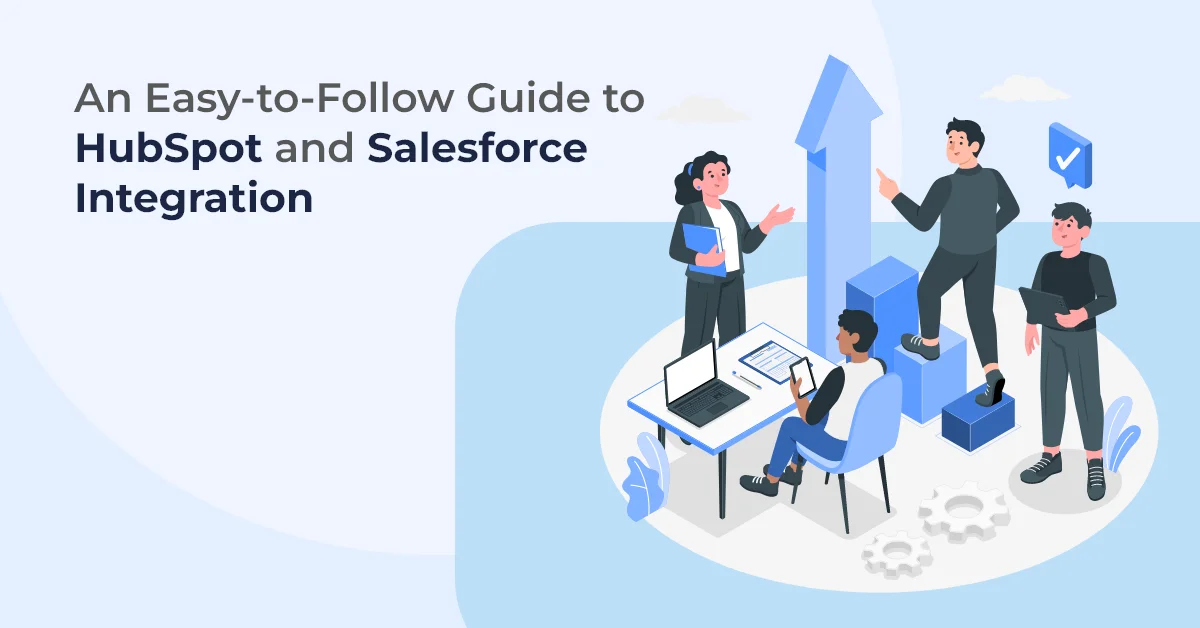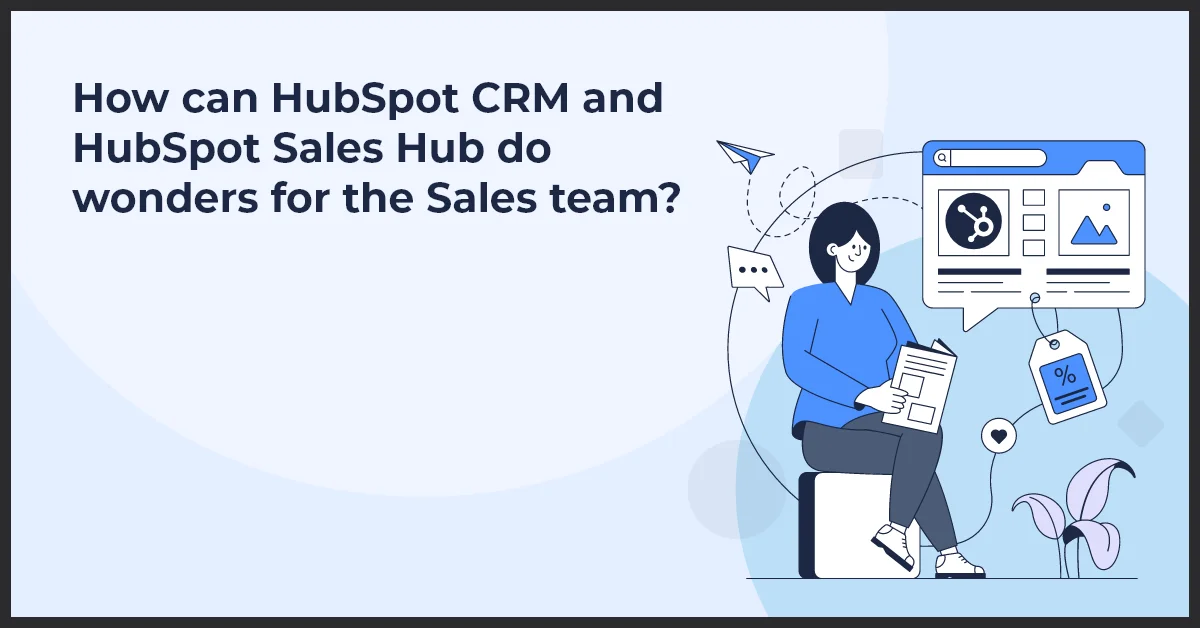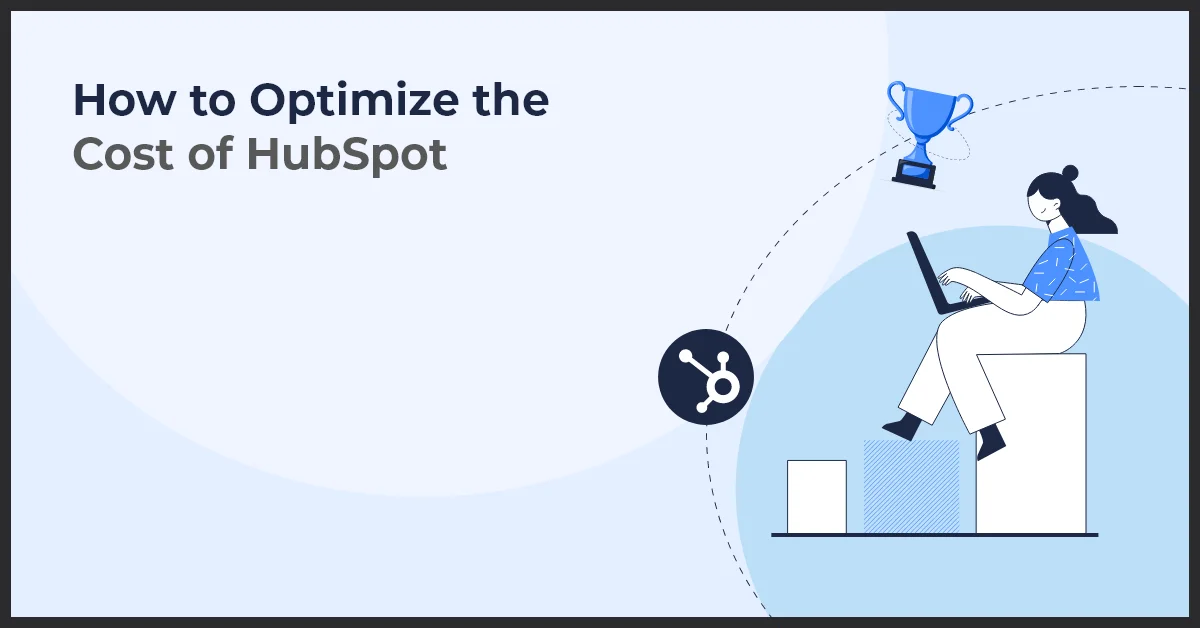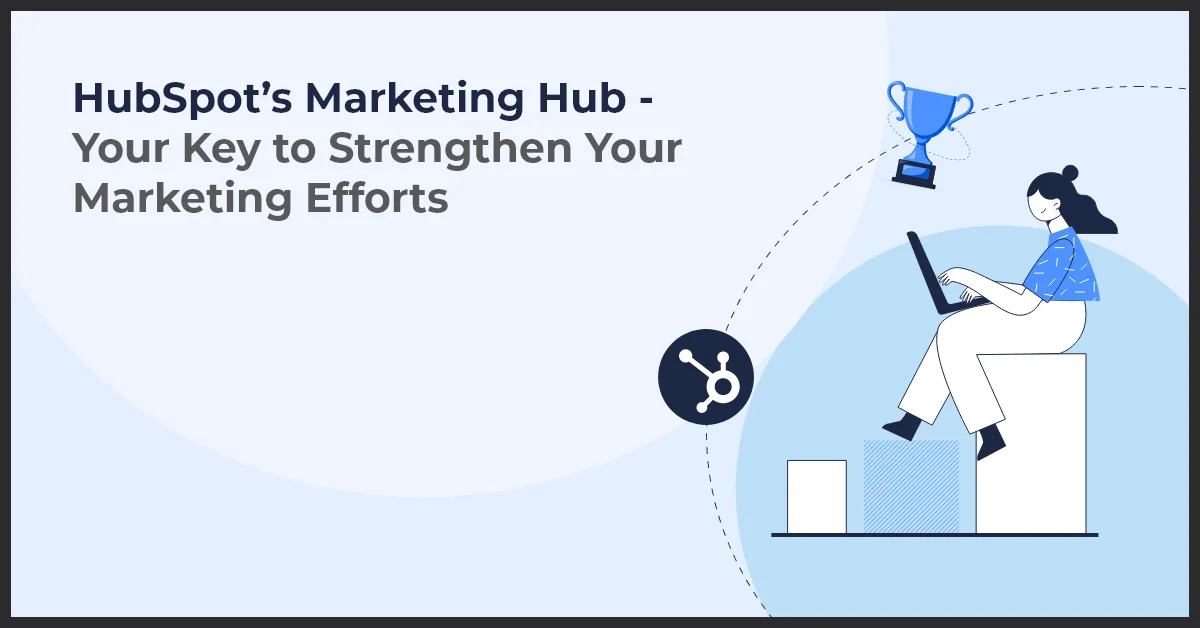An Easy-to-Follow Guide to HubSpot and Salesforce Integration

Published on: September 2, 2022
Updated on: September 19, 2024
2140 Views
- HubSpot
13 min read
Understanding HubSpot and Salesforce
HubSpot and Salesforce are two of the most popular customer relationship management (CRM) platforms in the market. Both offer a wide range of features and functionalities that can help businesses streamline their sales, marketing, and customer service processes. In this section, we will provide an overview of HubSpot and Salesforce's key features and functionalities, compare their capabilities and target audiences, and explain how the integration between the two platforms works.
Overview of HubSpot's Key Features and Functionalities
HubSpot is a comprehensive CRM platform that offers a suite of tools designed to help businesses attract, engage, and delight customers. Some of its key features and functionalities include:
- Lead Generation: HubSpot provides a range of tools for capturing leads, such as customizable forms, live chat, and pop-ups.
- Marketing Automation: With HubSpot, businesses can automate their marketing campaigns, including email marketing, social media posting, and lead nurturing.
- Content Management: The platform allows businesses to create and manage their website, blog, and landing pages.
- Sales Pipeline Management: HubSpot offers tools for tracking deals, managing contacts, and forecasting sales.
- Customer Service: Businesses can provide support and resolve customer issues using HubSpot's ticketing system and automation features.
Overview of Salesforce's Key Features and Functionalities
Salesforce is a robust CRM platform that caters to businesses of all sizes. It offers a wide range of features and functionalities, including:
- Sales Management: Salesforce provides tools for managing sales processes, such as lead and opportunity management, quote generation, and forecasting.
- Marketing Automation: Businesses can automate their marketing campaigns using Salesforce's email marketing, lead generation, and campaign management tools.
- Customer Service: Salesforce offers features for managing customer support, such as case management, knowledge base, and live chat.
- Analytics and Reporting: The platform allows users to track and analyze sales, marketing, and customer service metrics.
- Customizable Dashboards: Salesforce provides customizable dashboards that allow businesses to visualize their data in a way that is meaningful to them.
Comparison of HubSpot and Salesforce Capabilities and Target Audiences
While both HubSpot and Salesforce are powerful CRM platforms, they have different capabilities and target audiences:
- HubSpot: HubSpot is well-suited for small to mid-sized businesses that are primarily focused on inbound marketing and want an all-in-one CRM solution. It offers a user-friendly interface and a range of features aimed at helping businesses attract, engage, and delight their customers.
- Salesforce: Salesforce is a versatile CRM platform that caters to businesses of all sizes. It offers extensive customization capabilities and is often chosen by enterprises that require complex sales and marketing processes, as well as robust analytics and reporting functionalities.
Explanation of How the Integration Between the Two Platforms Works
The integration between HubSpot and Salesforce allows businesses to sync data seamlessly between the two platforms. This means that information such as leads, contacts, deals, and marketing activities can be shared and updated in real-time. The integration also enables businesses to automate workflows, streamline processes, and gain a holistic view of their customers across both platforms. By integrating HubSpot with Salesforce, businesses can leverage the strengths of both platforms to enhance their sales and marketing efforts.
Why Integrate HubSpot with Salesforce?
Integrating HubSpot with Salesforce offers numerous benefits for your business. By connecting these two powerful platforms, you can enhance your marketing and sales efforts, improve data flow, increase efficiency, and make more informed decisions. Here are the key reasons why integrating HubSpot with Salesforce is crucial:
- Improved marketing and sales alignment through streamlined data flow: Integration ensures seamless data synchronization between HubSpot and Salesforce, allowing marketing and sales teams to work collaboratively and access real-time, accurate information. This alignment leads to better lead management, improved targeting, and increased conversion rates.
- Increased efficiency by eliminating manual data entry and duplication: One of the biggest advantages of integration is eliminating the need for manual data entry and reducing the chances of data duplication. It saves time and minimizes errors, enabling your team to focus on revenue-generating activities rather than administrative tasks.
- Enhancing lead generation and nurturing through automated workflows: With integrated workflows, you can automate processes such as lead nurturing, scoring, and follow-ups. These automated workflows ensure that leads are properly nurtured and moved through the sales funnel efficiently.
- Maximizing sales pipeline management and visibility: Integration provides a holistic view of your customer's journey, allowing sales teams to gain complete visibility into the sales pipeline. This allows for better tracking, forecasting, and effective management of leads, opportunities, and deals.
- Leveraging comprehensive analytics and reporting for better decision-making: Integrating HubSpot with Salesforce enables you to consolidate and analyze data from both platforms, providing valuable insights into your marketing and sales performance. By leveraging comprehensive analytics and reporting, you can make data-driven decisions and optimize your strategies for maximum results.
Step-by-Step Guide to HubSpot Salesforce Integration
a. Preparing for Integration
- Understanding the prerequisites and requirements
- Creating a backup of existing data and configuration
- Ensuring data cleanliness and consistency
b. Configuring HubSpot and Salesforce for Integration
- Setting up HubSpot CRM and Salesforce accounts
- Installing and configuring the necessary integration tools
- Mapping fields and data synchronization settings
- Establishing data security and privacy measures
c. Syncing Data Between HubSpot and Salesforce
- Data syncing options and frequency
- Customizing data mappings and sync rules
- Troubleshooting common data syncing issues
d. Leveraging HubSpot Salesforce Integration for Business Goals
- Streamlining lead nurturing and qualification processes
- Enhancing customer data management across platforms
- Improving sales reporting and forecasting accuracy
- Integrating marketing and sales efforts for cohesive campaigns
- Enabling better customer service and support through unified data
Integration Best Practices and Tips
Successfully integrating HubSpot and Salesforce requires careful planning and ongoing attention to ensure optimal performance and efficiency. Here are some best practices and tips to consider:
- Establishing clear communication and alignment between marketing and sales teams: To maximize the benefits of integration, it is crucial to foster collaboration and ensure both teams are on the same page. Regular meetings and clear communication channels help align goals and strategies.
- Regularly monitoring and auditing data quality and consistency: Data integrity is crucial for accurate reporting and decision-making. Regularly review and clean up data to eliminate duplicates and inconsistencies, ensuring a reliable and unified view of your customer information.
- Maximizing the use of automation and workflows to save time and effort: Leverage the power of automation and workflows to streamline processes and eliminate manual tasks. Automate lead assignment, follow-ups, and data syncing to increase efficiency and reduce errors.
- Training and educating employees on the integrated CRM system: Providing comprehensive training and resources to employees using the integrated CRM system is essential for successful adoption. Invest in regular training sessions and provide documentation to ensure users understand how to fully utilize the integration.
- Staying updated with new features and updates from HubSpot and Salesforce: Both HubSpot and Salesforce regularly release updates and new features. Stay informed about these updates and assess how they can benefit your integration. Take advantage of new functionalities to further enhance your marketing and sales processes.
Marketing and sales technologies are constantly evolving now more than ever. While some companies may look for marketing automation and CRM solutions from a single vendor, most businesses opt in for integrated solutions when looking for the best fit. Two of the most powerful marketing and sales technology providers are HubSpot and Salesforce.
Both HubSpot and Salesforce distinguish themselves from other CRM platforms and marketing software by being practical, versatile, and able to address a range of business user demands—from marketing to sales. These two are extremely powerful tools in a company’s tech stack and getting the most out of both systems requires sophisticated strategies that leverage the strengths and limitations of the platforms.
Today we will help you figure out how you can achieve HubSpot and Salesforce integration to utilize their full potential, but first a little something about both the platforms.
HubSpot
HubSpot is a comprehensive marketing platform that offers lead management, marketing automation, content marketing, and analytics for landing pages. You can gather important data indicators and actively monitor them with top-notch HubSpot marketing tools to take advantage of performance gaps.
Salesforce
Salesforce is the best cloud-based sales platform, offering a variety of applications and robust CRM functionality. It makes it simpler for you to obtain the data you require, all in one view, and helps you manage customer data by helping you analyze consumer preferences, save and manage customer data. You can also boost sales and productivity, enhance internal communication, and track marketing activities and outcomes in real time using Salesforce CRM and its automation features.
4 Best Practices for Leveraging HubSpot and Salesforce Integration
Here are four best practices that can help you with your HubSpot and Salesforce integration seamlessly:
1. Know Your Sales Process
Learning about your sales process is important when it comes to integrating Salesforce and HubSpot. By understanding the sales process you will know what type of data needs to be captured in HubSpot and what data needs to be passed over to Salesforce.
Start information filtration by outlining the consumer information you need. If you choose to use prospecting calls, you can just pass leads and the question along. To make sure that your procedures are clear and founded on high standards of performance, you must qualify these leads.
You may make sure that you are further refining the leads by delving deeply into the data.
Before configuring the integration, you'll be addressing the buyer path and defining the necessary fields. You can use the integration incredibly quickly and successfully by briefly investigating and analyzing the data of your audience.
2. Avoid Syncing Your CRM Too Often
If you do not want your CRM to be too cluttered, do not opt for sync too often. For example, you are constantly syncing and saving every piece of data on your CRM. If that happens, your CRM will clog up with unprocessed/unorganized data. If data is synced often and leads are not nurtured or are irrelevant, your sales staff will waste time and be less productive
You can make sure your Salesforce integration is working properly by organizing all the necessary components, keeping highly qualified leads apart, and creating and creating all the necessary pieces.
3. Take Advantage of Hidden Fields
In HubSpot forms, there are certain useful hidden fields that you may use. With the use of these hidden fields, you can quickly and efficiently collect your prospects' information from Salesforce without them ever realizing it. By adding additional elements like lead source, buyer's journey/life cycle, or just assigning a lead owner, you may also get a little creative.
By minimizing the effort required to develop effective conversion funnels that harvest the user's data, these hidden fields can also aid segmentation and streamline internal operations.
4. Learn About Leads Contacts and Accounts in Salesforce
To develop the ideal fusion of both platforms, learning is a crucial component of the total effort. Understanding your salesforce platforms will help you to know how things function and how to handle everything without worry. You can exploit the combined functionality and use it to more effectively manage and keep track of your clients while reducing confusion in the long run by becoming familiar with the HubSpot Salesforce Platform.
How to Integrate HubSpot With Salesforce?
An inbuilt integration feature allows you to easily move data between HubSpot and Salesforce. It is quite simple to set up. All you need is a HubSpot marketing, sales or service hub professional account with admin access and have the HubSpot permission set assigned to you.
Steps to Integrate Salesforce and HubSpot
Installation
- Click the Marketplace button to access the marketplace in your HubSpot account. Choose associated apps from the "Manage." menu.
- The Visit App Marketplace button is located in the top-right corner.
- Click View integration after conducting a search for Salesforce integration. With this, the connector wizard will launch.
- The next step is to access Salesforce. Enter your Salesforce login information and click 'Log In' in the pop-up window. You will be returned to the HubSpot connector wizard once you have successfully logged in.
- The next step is to integrate HubSpot with Salesforce. To start the installation, select Start the Salesforce package here.
- After that, a link will take you to Salesforce where you may install the HubSpot connector package. Click Install after selecting the Install for All Users option. It could take up to ten minutes to finish the installation. Upon completion of the installation, you will receive an email.
- Return to the HubSpot connector wizard and select Next after the package has finished installing in Salesforce.
Adding HubSpot Visualforce Module to Salesforce
- This module allows you to view and filter contact activity, enroll contacts in HubSpot workflows, and determine how likely a contact is to close. Click Add HubSpot to Salesforce to continue.
- In order to add the HubSpot Visualforce module to Salesforce, you must follow the instructions provided in the connector wizard. Learn more about this module and how to add it by visiting this page.
- When finished, select Next.
- The choice of how data will sync between HubSpot and Salesforce is the last step.
- Click on Review settings if you select the Recommended setup.
Advanced Setup
- Now you need to set-up your contact sync settings.
- From the drop-down menu, select the contacts you want to sync. To sync all contacts with Salesforce, you may also select the Select All option. then select Next.
- Now is the moment to configure your task and activity sync settings:
- Choose the appropriate choice, then click Next to enable the Salesforce task sync switch, which will prompt HubSpot to create a task whenever one is created in Salesforce.
- Then set up your sync settings.
- You must lastly review your chosen data sync settings. You can click Change to change a data sync type's settings. After finishing, click Finish setup to start synchronizing.
- You'll be taken to your settings for integrating Salesforce.
- Salesforce and HubSpot will start syncing!
Congratulations! You are all done!!
Wrapping Up
The marketing tactics of most businesses have moved past the point of just ‘cold calling’ and the time has come for smart inbound marketing. And for that, HubSpot and Salesforce integration can help you improve the effectiveness of your marketing campaigns while increasing ROI. By using HubSpot and Salesforce integration best practices, you will be able to get clean data without duplicates or other errors and also significantly improve the consistency of both decisions, leading to a more effective marketing and sales strategy.
If you think you need help with a smooth and seamless HubSpot and Salesforce integration for your business, then we are here to help! Our experts at Growth Natives will guide you through every step of the way and ensure your business gets the most out of this integration. Ready to talk? Email us at info@growthnatives.com.
Frequently Asked Questions
HubSpot can integrate with Salesforce through a bi-directional sync that allows for the transfer of data between the two systems. The integration can be set up to sync contacts, leads, opportunities, and other data points, ensuring that both systems have up-to-date information.
The ease of use of HubSpot vs. Salesforce depends on individual preferences and needs. HubSpot is often praised for its user-friendly interface and intuitive design, making it easier for users to navigate and use. Salesforce, on the other hand, offers more advanced features and customization options, which can make it more complex for some users.
To sync Salesforce tasks with HubSpot, you can use the HubSpot-Salesforce integration. Once the integration is set up, tasks created in Salesforce can be synced to HubSpot, and vice versa. This allows for a seamless workflow between the two systems and ensures that tasks are updated in real-time.
To manually sync HubSpot with Salesforce, you can use the “Sync Now” option in the HubSpot-Salesforce integration settings. This will initiate a sync between the two systems, updating any changes or new data points. Alternatively, you can set up automatic syncing schedules to ensure that data is synced regularly without manual intervention.



